FREE US SHIPPING on the Postcards!
*** FIND US ON FACEBOOK **
"North Star Antiques"
@Northstarantiques
FOR YOU TO CONSIDER NOW:
RP Elizabeth Taylor 3 x 5 Hollywood Movie Star Fan Club printed signature Real Photo
*Authentication: We have a large selection of autographed / signed Hollywood - movie star photos from the 40's. These are from a large personal collection - some signed directly to her (Joan)
It appears that most of the 3 x 5 are all printed versions of their signature. But there may be some real ink signatures in this grouping. I am sending them all to auction at the same low price (6.95) and will let you decide. These are all in excellent condition unless stated otherwise under "Condition"
This grouping is the 4th and final round - these are ALL 3 x 5 Real Photos -other previous listings may be listed now under "Buy It Now's" These are all postcard size - some are printed as postcards and were mailed while some have plain white backs
About : Elizabeth Taylor
Dame Elizabeth Rosemond Taylor DBE (27 February 1932 – 23 March 2011) was a British and American actress. She began her career as a child actress in the early 1940s and was one of the most popular stars of classical Hollywood cinema in the 1950s. She then became the world's highest paid movie star in the 1960s, remaining a well-known public figure for the rest of her life. In 1999, the American Film Institute ranked her seventh on its greatest female screen legends list.
Born in London to socially prominent American parents, Taylor moved with her family to Los Angeles in 1939 at the age of 7. She made her acting debut with a minor role in the Universal Pictures film There's One Born Every Minute (1942), but the studio ended her contract after a year. She was then signed by Metro-Goldwyn-Mayer and became a popular teen star after appearing in National Velvet (1944). She transitioned to mature roles in the 1950s, when she starred in the comedy Father of the Bride (1950) and received critical acclaim for her performance in the drama A Place in the Sun (1951). She starred in the historical adventure epic Ivanhoe (1952) with Robert Taylor and Joan Fontaine. Despite being one of MGM's most bankable stars, Taylor wished to end her career in the early 1950s. She resented the studio's control and disliked many of the films to which she was assigned.
She began receiving more enjoyable roles in the mid-1950s, beginning with the epic drama Giant (1956), and starred in several critically and commercially successful films in the following years. These included two film adaptations of plays by Tennessee Williams: Cat on a Hot Tin Roof (1958), and Suddenly, Last Summer (1959); Taylor won a Golden Globe for Best Actress for the latter. Although she disliked her role as a call girl in BUtterfield 8 (1960), her last film for MGM, she won the Academy Award for Best Actress for her performance. During the production of the film Cleopatra in 1961, Taylor and co-star Richard Burton began an extramarital affair, which caused a scandal. Despite public disapproval, they continued their relationship and were married in 1964. Dubbed "Liz and Dick" by the media, they starred in 11 films together, including The V.I.P.s (1963), The Sandpiper (1965), The Taming of the Shrew (1967), and Who's Afraid of Virginia Woolf? (1966). Taylor received the best reviews of her career for Woolf, winning her second Academy Award and several other awards for her performance. She and Burton divorced in 1974 but reconciled soon after, remarrying in 1975. The second marriage ended in divorce in 1976.
Taylor's acting career began to decline in the late 1960s, although she continued starring in films until the mid-1970s, after which she focused on supporting the career of her sixth husband, United States Senator John Warner. In the 1980s, she acted in her first substantial stage roles and in several television films and series. She became the second celebrity to launch a perfume brand after Sophia Loren. Taylor was one of the first celebrities to take part in HIV/AIDS activism. She co-founded the American Foundation for AIDS Research in 1985 and the Elizabeth Taylor AIDS Foundation in 1991. From the early 1990s until her death, she dedicated her time to philanthropy, for which she received several accolades, including the Presidential Citizens Medal.
Throughout her career, Taylor's personal life was the subject of constant media attention. She was married eight times to seven men, converted to Judaism, endured several serious illnesses, and led a jet set lifestyle, including assembling one of the most expensive private collections of jewelry in the world. After many years of ill health, Taylor died from congestive heart failure in 2011, at the age of 79.
Acting career[edit]
1941–1949: Early roles and teenage stardom[edit]
In California, Taylor's mother was frequently told that her daughter should audition for films.[1]: 27–30 Taylor's eyes in particular, drew attention; they were blue, to the extent of appearing violet, and were rimmed by dark double eyelashes caused by a genetic mutation.[7][1]: 9 Sara was initially opposed to Taylor appearing in films, but after the outbreak of war in Europe made return there unlikely, she began to view the film industry as a way of assimilating to American society.[1]: 27–30 Francis Taylor's Beverly Hills gallery had gained clients from the film industry soon after opening, helped by the endorsement of gossip columnist Hedda Hopper, a friend of the Cazalets.[1]: 27–31 Through a client and a school friend's father, Taylor auditioned for both Universal Pictures and Metro-Goldwyn-Mayer in early 1941.[8]: 27–37 Both studios offered Taylor contracts, and Sara Taylor chose to accept Universal's offer.[8]: 27–37
Taylor began her contract in April 1941 and was cast in a small role in There's One Born Every Minute (1942).[8]: 27–37 She did not receive other roles, and her contract was terminated after a year.[8]: 27–37 Universal's casting director explained her dislike of Taylor, stating that "the kid has nothing ... her eyes are too old, she doesn't have the face of a child."[8]: 27–37 Biographer Alexander Walker agrees that Taylor looked different from the child stars of the era, such as Shirley Temple and Judy Garland.[8]: 32 Taylor later said that, "apparently, I used to frighten grown ups, because I was totally direct."[9]
Taylor received another opportunity in late 1942, when her father's acquaintance, MGM producer Samuel Marx, arranged for her to audition for a minor role in Lassie Come Home (1943), which required a child actress with an English accent .[1]: 22–23, 27–37 After a trial contract of three months, she was given a standard seven-year contract in January 1943.[1]: 38–41 Following Lassie, she appeared in minor uncredited roles in two other films set in England – Jane Eyre (1943) playing Helen Burns, and The White Cliffs of Dover (1944).[1]: 38–41
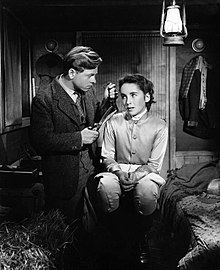
Taylor was cast in her first starring role at the age of 12, when she was chosen to play a girl who wants to compete as a jockey in the exclusively male Grand National in National Velvet.[1]: 40–47 She later called it "the most exciting film" of her career.[10] MGM had been looking for a suitable actress with a British accent and the ability to ride horses since 1937, and chose Taylor at the recommendation of White Cliffs director Clarence Brown, who knew she had the required skills.[1]: 40–47 As she was deemed too short, filming was pushed back several months to allow her to grow; she spent the time practicing riding.[1]: 40–47 In developing her into a new star, MGM required her to wear braces to correct her teeth, and had two of her baby teeth pulled out.[1]: 40–47 The studio also wanted to dye her hair and change the shape of her eyebrows, and proposed that she use the screen name "Virginia", but Taylor and her parents refused.[9]
National Velvet became a box-office success upon its release on Christmas 1944.[1]: 40–47 Bosley Crowther of The New York Times stated that "her whole manner in this picture is one of refreshing grace",[11] while James Agee of The Nation wrote that she "is rapturously beautiful... I hardly know or care whether she can act or not."[12]
Taylor later stated that her childhood ended when she became a star, as MGM started to control every aspect of her life.[9][13][1]: 48–51 She described the studio as a "big extended factory", where she was required to adhere to a strict daily schedule:[9] days were spent attending school and filming at the studio lot, and evenings in dancing and singing classes, and in practicing the following day's scenes.[1]: 48–51 Following the success of National Velvet, MGM gave Taylor a new seven-year contract with a weekly salary of $750, and cast her in a minor role in the third film of the Lassie series, Courage of Lassie (1946).[1]: 51–58 The studio also published a book of Taylor's writings about her pet chipmunk, Nibbles and Me (1946), and had paper dolls and coloring books made after her.[1]: 51–58
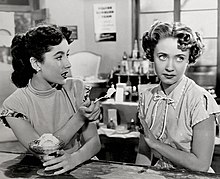
When Taylor turned 15 in 1947, MGM began to cultivate a more mature public image for her by organizing photo shoots and interviews that portrayed her as a "normal" teenager attending parties and going on dates.[8]: 56–57, 65–74 Film magazines and gossip columnists also began comparing her to older actresses such as Ava Gardner and Lana Turner.[8]: 71 Life called her "Hollywood's most accomplished junior actress" for her two film roles that year.[8]: 69 In the critically panned Cynthia (1947), Taylor portrayed a frail girl who defies her over-protective parents to go to the prom; in the period film Life with Father (1947), opposite William Powell and Irene Dunne, she portrayed the love interest of a stockbroker's son.[14][1]: 58–70 [15]
They were followed by supporting roles as a teenaged "man-stealer" who seduces her peer's date to a high school dance in the musical A Date with Judy (1948), and as a bride in the romantic comedy Julia Misbehaves (1948). This became a commercial success, grossing over $4 million in the box office.[16][1]: 82 Taylor's last adolescent role was as Amy March in Mervyn LeRoy's Little Women (1949), a box-office success.[17] The same year, Time featured Taylor on its cover, and called her the leader among Hollywood's next generation of stars, "a jewel of great price, a true sapphire."[18]
1950–1951: Transition to adult roles[edit]
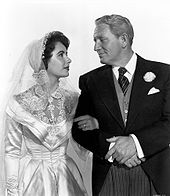
Taylor made the transition to adult roles when she turned 18 in 1950. In her first mature role, the thriller Conspirator (1949), she plays a woman who begins to suspect that her husband is a Soviet spy.[1]: 75–83 Taylor had been only 16 at the time of its filming, but its release was delayed until March 1950, as MGM disliked it and feared it could cause diplomatic problems.[1]: 75–83 [19] Taylor's second film of 1950 was the comedy The Big Hangover (1950), co-starring Van Johnson.[20] It was released in May. That same month, Taylor married hotel-chain heir Conrad "Nicky" Hilton Jr. in a highly publicized ceremony.[1]: 99–105 The event was organized by MGM, and used as part of the publicity campaign for Taylor's next film, Vincente Minnelli's comedy Father of the Bride (1950), in which she appeared opposite Spencer Tracy and Joan Bennett as a bride preparing for her wedding.[1]: 99–105 The film became a box-office success upon its release in June, grossing $6 million worldwide ($75,983,402 in 2023 dollars [21]), and was followed by a successful sequel, Father's Little Dividend (1951), ten months later.[22]

Taylor's next film release, George Stevens' A Place in the Sun (1951), marked a departure from her earlier films. According to Taylor, it was the first film in which she had been asked to act, instead of simply being herself,[13] and it brought her critical acclaim for the first time since National Velvet.[1]: 96–97 Based on Theodore Dreiser's novel An American Tragedy (1925), it featured Taylor as a spoiled socialite who comes between a poor factory worker (Montgomery Clift) and his pregnant girlfriend (Shelley Winters).[1]: 91 Stevens cast Taylor as she was "the only one ... who could create this illusion" of being "not so much a real girl as the girl on the candy-box cover, the beautiful girl in the yellow Cadillac convertible that every American boy sometime or other thinks he can marry."[1]: 92 [23]
A Place in the Sun was a critical and commercial success, grossing $3 million.[24] Herb Golden of Variety said that Taylor's "histrionics are of a quality so far beyond anything she has done previously, that Stevens' skilled hands on the reins must be credited with a minor miracle."[25] A.H. Weiler of The New York Times wrote that she gives "a shaded, tender performance, and one in which her passionate and genuine romance avoids the pathos common to young love as it sometimes comes to the screen."[26]
1952–1955: Continued success at MGM[edit]

Taylor next starred in the romantic comedy Love Is Better Than Ever (1952).[1]: 124–125 According to Alexander Walker, MGM cast her in the "B-picture" as a reprimand for divorcing Hilton in January 1951 after only eight months of marriage, which had caused a public scandal that reflected negatively on her.[1]: 124–125 After completing Love Is Better Than Ever, Taylor was sent to Britain to take part in the historical epic Ivanhoe (1952), which was one of the most expensive projects in the studio's history.[1]: 129–132 She was not happy about the project, finding the story superficial and her role as Rebecca too small.[1]: 129–132 Regardless, Ivanhoe became one of MGM's biggest commercial successes, earning $11 million in worldwide rentals.[27]

Taylor's last film made under her old contract with MGM was The Girl Who Had Everything (1953), a remake of the pre-code drama A Free Soul (1931).[1]: 145 Despite her grievances with the studio, Taylor signed a new seven-year contract with MGM in the summer of 1952.[1]: 139–143 Although she wanted more interesting roles, the decisive factor in continuing with the studio was her financial need; she had recently married British actor Michael Wilding, and was pregnant with her first child.[1]: 139–143 In addition to granting her a weekly salary of $4,700 ($53,524 in 2023 dollars [21]), MGM agreed to give the couple a loan for a house, and signed her husband for a three-year contract.[1]: 141–143 Due to her financial dependency, the studio now had even more control over her than previously.[1]: 141–143

Taylor's first two films made under her new contract were released ten days apart in early 1954.[1]: 153 The first was Rhapsody, a romantic film starring her as a woman caught in a love triangle with two musicians. The second was Elephant Walk, a drama in which she played a British woman struggling to adapt to life on her husband's tea plantation in Ceylon. She had been loaned to Paramount Pictures for the film after its original star, Vivien Leigh, fell ill.[1]: 148–149
In the fall, Taylor starred in two more film releases. Beau Brummell was a Regency era period film, another project in which she was cast against her will.[1]: 153–154 Taylor disliked historical films in general, as their elaborate costumes and make-up required her to wake up earlier than usual to prepare. She later said that she gave one of the worst performances of her career in Beau Brummell.[1]: 153–154 The second film was Richard Brooks' The Last Time I Saw Paris, based on F. Scott Fitzgerald's short story. Although she had wanted to be cast in The Barefoot Contessa (1954) instead, Taylor liked the film, and later stated that it "convinced me I wanted to be an actress instead of yawning my way through parts."[1]: 153–157 [28] While The Last Time I Saw Paris was not as profitable as many other MGM films, it garnered positive reviews.[1]: 153–157 [28] Taylor became pregnant again during the production, and had to agree to add another year to her contract to make up for the period spent on maternity leave.[1]: 153–157
1956–1960: Critical acclaim[edit]
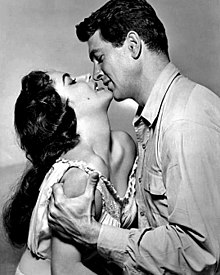
By the mid-1950s, the American film industry was beginning to face serious competition from television, which resulted in studios producing fewer films, and focusing instead on their quality.[8]: 158–165 The change benefited Taylor, who finally found more challenging roles after several years of career disappointments.[8]: 158–165 After lobbying director George Stevens, she won the female lead role in Giant (1956), an epic drama about a ranching dynasty, which co-starred Rock Hudson and James Dean.[8]: 158–165 Its filming in Marfa, Texas, was a difficult experience for Taylor, as she clashed with Stevens, who wanted to break her will to make her easier to direct, and was often ill, resulting in delays.[8]: 158–165 [29] To further complicate the production, Dean died in a car accident only days after completing filming; the grieving Taylor still had to film reaction shots to their joint scenes.[8]: 158–166 When Giant was released a year later, it became a box-office success, and was widely praised by critics.[8]: 158–165 Although not nominated for an Academy Award like her co-stars, Taylor garnered positive reviews for her performance, with Variety calling it "surprisingly clever",[30] and The Manchester Guardian lauding her acting as "an astonishing revelation of unsuspected gifts." It named her one of the film's strongest assets.[31]
MGM re-united Taylor with Montgomery Clift in Raintree County (1957), a Civil War drama which it hoped would replicate the success of Gone with the Wind (1939).[1]: 166–177 Taylor found her role as a mentally disturbed Southern belle fascinating, but overall disliked the film.[1]: 166–177 Although the film failed to become the type of success MGM had planned,[32] Taylor was nominated for the first time for an Academy Award for Best Actress for her performance.[33]

Taylor considered her next performance as Maggie the Cat in the screen adaptation of the Tennessee Williams play Cat on a Hot Tin Roof (1958) a career "high point." But it coincided with one of the most difficult periods in her personal life.[13] After completing Raintree Country, she had divorced Wilding and married producer Mike Todd. She had completed only two weeks of filming in March 1958, when Todd was killed in a plane crash.[1]: 186–194 Although she was devastated, pressure from the studio and the knowledge that Todd had large debts led Taylor to return to work only three weeks later.[1]: 195–203 She later said that "in a way ... [she] became Maggie", and that acting "was the only time I could function" in the weeks after Todd's death.[13]
During the production, Taylor's personal life drew more attention when she began an affair with singer Eddie Fisher, whose marriage to actress Debbie Reynolds had been idealized by the media as the union of "America's sweethearts."[1]: 203–210 The affair – and Fisher's subsequent divorce – changed Taylor's public image from a grieving widow to a "homewrecker". MGM used the scandal to its advantage by featuring an image of Taylor posing on a bed in a slip in the film's promotional posters.[1]: 203–210 Cat grossed $10 million in American cinemas alone, and made Taylor the year's second-most profitable star.[1]: 203–210 She received positive reviews for her performance, with Bosley Crowther of The New York Times calling her "terrific",[34] and Variety praising her for "a well-accented, perceptive interpretation."[35] Taylor was nominated for an Academy Award[33] and a BAFTA.[36]
Taylor's next film, Joseph L. Mankiewicz's Suddenly, Last Summer (1959), was another Tennessee Williams adaptation, with a screenplay by Gore Vidal and also starring Montgomery Clift and Katharine Hepburn. The independent production earned Taylor $500,000 for playing the role of a severely traumatized patient in a mental institution.[1]: 203–210 Although the film was a drama about mental illness, childhood traumas, and homosexuality, it was again promoted with Taylor's sex appeal; both its trailer and poster featured her in a white swimsuit. The strategy worked, as the film was a financial success.[37] Taylor received her third Academy Award nomination[33] and her first Golden Globe for Best Actress for her performance.[1]: 203–210
By 1959, Taylor owed one more film for MGM, which it decided should be BUtterfield 8 (1960), a drama about a high-class call girl, in an adaptation of a John O'Hara 1935 novel of the same name.[1]: 211–223 The studio correctly calculated that Taylor's public image would make it easy for audiences to associate her with the role.[1]: 211–223 She hated the film for the same reason, but had no choice in the matter, although the studio agreed to her demands of filming in New York and casting Eddie Fisher in a sympathetic role.[1]: 211–223 As predicted, BUtterfield 8 was a major commercial success, grossing $18 million in world rentals.[1]: 224–236 Crowther wrote that Taylor "looks like a million dollars, in mink or in negligée",[38] while Variety stated that she gives "a torrid, stinging portrayal with one or two brilliantly executed passages within."[39] Taylor won her first Academy Award for Best Actress for her performance.[1]: 224–236
1961–1967: Cleopatra and other collaborations with Richard Burton[edit]

After completing her MGM contract, Taylor starred in 20th Century-Fox's Cleopatra (1963). According to film historian Alexander Doty, this historical epic made her more famous than ever before.[40] She became the first movie star to be paid $1 million for a role; Fox also granted her 10% of the film's gross profits, as well as shooting the film in Todd-AO, a widescreen format for which she had inherited the rights from Mike Todd.[8]: 10–11 [1]: 211–223 The film's production – characterized by costly sets and costumes, constant delays, and a scandal caused by Taylor's extramarital affair with her co-star Richard Burton – was closely followed by the media, with Life proclaiming it the "Most Talked About Movie Ever Made."[8]: 11–12, 39, 45–46, 56 Filming began in England in 1960, but had to be halted several times because of bad weather and Taylor's ill health.[8]: 12–13 In March 1961, she developed nearly fatal pneumonia, which necessitated a tracheotomy; one news agency erroneously reported that she had died.[8]: 12–13 Once she had recovered, Fox discarded the already filmed material, and moved the production to Rome, changing its director to Joseph Mankiewicz, and the actor playing Mark Antony to Burton.[8]: 12–18 Filming was finally completed in July 1962.[8]: 39 The film's final cost was $62 million (equivalent to $625 million in 2023), making it the most expensive film made up to that point.[8]: 46
Cleopatra became the biggest box-office success of 1963 in the United States; the film grossed $15.7 million at the box office (equivalent to $156 million in 2023).[8]: 56–57 Regardless, it took several years for the film to earn back its production costs, which drove Fox near to bankruptcy. The studio publicly blamed Taylor for the production's troubles and unsuccessfully sued Burton and Taylor for allegedly damaging the film's commercial prospects with their behavior.[8]: 46 The film's reviews were mixed to negative, with critics finding Taylor overweight and her voice too thin, and unfavorably comparing her with her classically trained British co-stars.[8]: 56–58 [1]: 265–267 [41] In retrospect, Taylor called Cleopatra a "low point" in her career, and said that the studio had cut out the scenes which she felt provided the "core of the characterization."[13]
Taylor intended to follow Cleopatra by headlining an all-star cast in Fox's black comedy What a Way to Go! (1964), but negotiations fell through, and Shirley MacLaine was cast instead. In the meantime, film producers were eager to profit from the scandal surrounding Taylor and Burton, and they next starred together in Anthony Asquith's The V.I.P.s (1963), which mirrored the headlines about them.[8]: 42–45 [1]: 252–255, 260–266 Taylor played a famous model attempting to leave her husband for a lover, and Burton her estranged millionaire husband. Released soon after Cleopatra, it became a box-office success.[1]: 264 Taylor was also paid $500,000 (equivalent to $4.98 million in 2023) to appear in a CBS television special, Elizabeth Taylor in London, in which she visited the city's landmarks and recited passages from the works of famous British writers.[8]: 74–75
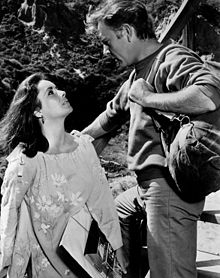
After completing The V.I.P.s, Taylor took a two-year hiatus from films, during which she and Burton divorced their spouses and married each other.[8]: 112 The supercouple continued starring together in films in the mid-1960s, earning a combined $88 million over the next decade; Burton once stated, "They say we generate more business activity than one of the smaller African nations."[8]: 193 [42] Biographer Alexander Walker compared these films to "illustrated gossip columns", as their film roles often reflected their public personae, while film historian Alexander Doty has noted that the majority of Taylor's films during this period seemed to "conform to, and reinforce, the image of an indulgent, raucous, immoral or amoral, and appetitive (in many senses of the word) 'Elizabeth Taylor'".[1]: 294 [43] Taylor and Burton's first joint project following her hiatus was Vincente Minelli's romantic drama The Sandpiper (1965), about an illicit love affair between a bohemian artist and a married clergyman in Big Sur, California. Its reviews were largely negative, but it grossed a successful $14 million in the box office (equivalent to $135 million in 2023).[8]: 116–118
Their next project, Who's Afraid of Virginia Woolf? (1966), an adaptation of a play of the same name by Edward Albee, featured the most critically acclaimed performance of Taylor's career.[8]: 142, 151–152 [1]: 286 She and Burton starred as Martha and George, a middle-aged couple going through a marital crisis. In order to convincingly play 50-year-old Martha, Taylor gained weight, wore a wig, and used make-up to make herself look older and tired – in stark contrast to her public image as a glamorous film star.[8]: 136–137 [1]: 281–282 At Taylor's suggestion, theatre director Mike Nichols was hired to direct the project, despite his lack of experience with film.[8]: 139–140 The production differed from anything she had done previously, as Nichols wanted to thoroughly rehearse the play before beginning filming.[8]: 141 Woolf was considered ground-breaking for its adult themes and uncensored language, and opened to "glorious" reviews.[8]: 140, 151 Variety wrote that Taylor's "characterization is at once sensual, spiteful, cynical, pitiable, loathsome, lustful, and tender."[44] Stanley Kauffmann of The New York Times stated that she "does the best work of her career, sustained and urgent."[45] The film also became one of the biggest commercial successes of the year.[8]: 151–152 [1]: 286 Taylor received her second Academy Award, and BAFTA, National Board of Review, and New York City Film Critics Circle awards for her performance.

In 1966, Taylor and Burton performed Doctor Faustus for a week in Oxford to benefit the Oxford University Dramatic Society; he starred and she appeared in her first stage role as Helen of Troy, a part which required no speaking.[8]: 186–189 Although it received generally negative reviews, Burton produced it as a film, Doctor Faustus (1967), with the same cast.[8]: 186–189 It was also panned by critics and grossed only $600,000 in the box office (equivalent to $5.48 million in 2023).[8]: 230–232 Taylor and Burton's next project, Franco Zeffirelli's The Taming of the Shrew (1967), which they also co-produced, was more successful.[8]: 164 It posed another challenge for Taylor, as she was the only actor in the project with no previous experience of performing Shakespeare; Zeffirelli later stated that this made her performance interesting, as she "invented the part from scratch."[8]: 168 Critics found the play to be fitting material for the couple, and the film became a box-office success by grossing $12 million (equivalent to $109.65 million in 2023).[8]: 181, 186
Taylor's third film released in 1967, John Huston's Reflections in a Golden Eye, was her first without Burton since Cleopatra. Based on a novel of the same name by Carson McCullers, it was a drama about a repressed gay military officer and his unfaithful wife. It was originally slated to co-star Taylor's old friend Montgomery Clift, whose career had been in decline for several years owing to his substance abuse problems. Determined to secure his involvement in the project, Taylor even offered to pay for his insurance.[8]: 157–161 But Clift died from a heart attack before filming began; he was replaced in the role by Marlon Brando.[8]: 175, 189 Reflections was a critical and commercial failure at the time of its release.[8]: 233–234 Taylor and Burton's last film of the year was the adaptation of Graham Greene's novel, The Comedians, which received mixed reviews and was a box-office disappointment.[8]: 228–232
Bid with confidence!
MORE AUTOGRAPHED PHOTOS & HOLLYWOOD PHOTOS NOW